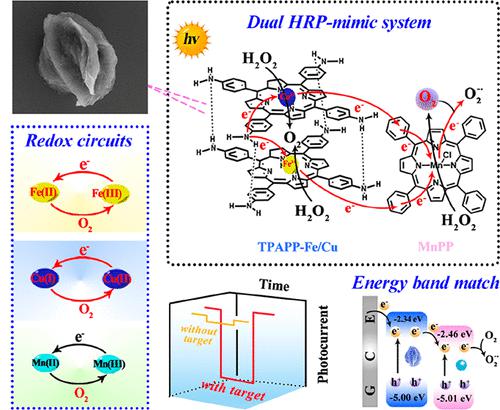当前位置:
X-MOL 学术
›
Anal. Chem.
›
论文详情
Our official English website, www.x-mol.net, welcomes your
feedback! (Note: you will need to create a separate account there.)
Metal Porphyrin Complex Combined with Polymerization and Isomerization Cyclic Amplification for a Sensitive Photoelectrochemical Assay
Analytical Chemistry ( IF 6.7 ) Pub Date : 2023-03-10 , DOI: 10.1021/acs.analchem.3c00167 Qingyuan Dong 1 , Qiao Ding 1 , Ruo Yuan 1 , Yali Yuan 1
Analytical Chemistry ( IF 6.7 ) Pub Date : 2023-03-10 , DOI: 10.1021/acs.analchem.3c00167 Qingyuan Dong 1 , Qiao Ding 1 , Ruo Yuan 1 , Yali Yuan 1
Affiliation

|
5,10,15,20-Tetrakis(4-aminophenyl)-21H,23H-porphine (TPAPP) possesses good light-harvesting ability and photoelectrochemical (PEC) cathode response signal; however, the disadvantages of easy stacking and weak hydrophilicity limit its application as a signal probe in PEC biosensors. Based on these, we prepared a Fe3+ and Cu2+ co-coordinating photoactive material (TPAPP-Fe/Cu) with horseradish peroxidase (HRP)-like activity. The metal ions in the porphyrin center not only enabled the directional flow of photogenerated electrons between electron-rich porphyrin and positive metal ions within inner-/intermolecular layers but also accelerated electron transfer through a synergistic redox reaction of Fe(III)/Fe(II) and Cu(II)/Cu(I) as well as rapid generation of superoxide anion radicals (O2–•) by mimicking catalytically produced and dissolved oxygen, thereby providing the desired cathode photoactive material with extremely high photoelectric conversion efficiency. Accordingly, by combining with toehold-mediated strand displacement (TSD)-induced single cycle and polymerization and isomerization cyclic amplification (PICA), an ultrasensitive PEC biosensor was constructed for the detection of colon cancer-related miRNA-182-5p. The ultratrace target could be converted to abundant output DNA by TSD possessing the desirable amplifying ability to trigger PICA for forming long ssDNA with repetitive sequences, thus decorating substantial TPAPP-Fe/Cu-labeled DNA signal probes for producing high PEC photocurrent. Meanwhile, the Mn(III) meso-tetraphenylporphine chloride (MnPP) was embedded in dsDNA to further exhibit a sensitization effect toward TPAPP-Fe/Cu and an acceleration effect analogous to that of metal ions in the porphyrin center above. As a result, the proposed biosensor displayed a detection limit as low as 0.2 fM, facilitating the development of high-performance biosensors and showing great potential in early clinical diagnosis.
中文翻译:

金属卟啉络合物结合聚合和异构化循环放大用于灵敏的光电化学分析
5,10,15,20-四(4-氨基苯基)-21H,23H-卟啉(TPAPP)具有良好的光捕获能力和光电化学(PEC)阴极响应信号;然而,易堆叠和亲水性弱等缺点限制了其作为信号探针在PEC生物传感器中的应用。基于这些,我们制备了一种具有类辣根过氧化物酶(HRP)活性的Fe 3+和Cu 2+共配位光敏材料(TPAPP-Fe/Cu)。卟啉中心的金属离子不仅使光生电子在富电子卟啉和分子间层内的正金属离子之间定向流动,而且通过 Fe(III)/Fe(II) 的协同氧化还原反应加速电子转移) 和 Cu(II)/Cu(I) 以及超氧阴离子自由基 (O2 –•)通过模拟催化产生和溶解的氧,从而提供具有极高光电转换效率的所需阴极光活性材料。因此,通过结合立足点介导的链置换 (TSD) 诱导的单循环和聚合异构化循环扩增 (PICA),构建了超灵敏的 PEC 生物传感器,用于检测结肠癌相关的 miRNA-182-5p。TSD 可以将超痕量目标转化为丰富的输出 DNA,TSD 具有触发 PICA 以形成具有重复序列的长 ssDNA 的理想放大能力,从而装饰大量 TPAPP-Fe/Cu 标记的 DNA 信号探针以产生高 PEC 光电流。同时,将 Mn(III) meso-tetraphenylporphine chloride (MnPP) 包埋在 dsDNA 中,进一步表现出对 TPAPP-Fe/Cu 的敏化作用和类似于上述卟啉中心金属离子的加速作用。因此,所提出的生物传感器显示出低至 0.2 fM 的检测限,促进了高性能生物传感器的开发,并在早期临床诊断中显示出巨大潜力。
更新日期:2023-03-10
中文翻译:

金属卟啉络合物结合聚合和异构化循环放大用于灵敏的光电化学分析
5,10,15,20-四(4-氨基苯基)-21H,23H-卟啉(TPAPP)具有良好的光捕获能力和光电化学(PEC)阴极响应信号;然而,易堆叠和亲水性弱等缺点限制了其作为信号探针在PEC生物传感器中的应用。基于这些,我们制备了一种具有类辣根过氧化物酶(HRP)活性的Fe 3+和Cu 2+共配位光敏材料(TPAPP-Fe/Cu)。卟啉中心的金属离子不仅使光生电子在富电子卟啉和分子间层内的正金属离子之间定向流动,而且通过 Fe(III)/Fe(II) 的协同氧化还原反应加速电子转移) 和 Cu(II)/Cu(I) 以及超氧阴离子自由基 (O2 –•)通过模拟催化产生和溶解的氧,从而提供具有极高光电转换效率的所需阴极光活性材料。因此,通过结合立足点介导的链置换 (TSD) 诱导的单循环和聚合异构化循环扩增 (PICA),构建了超灵敏的 PEC 生物传感器,用于检测结肠癌相关的 miRNA-182-5p。TSD 可以将超痕量目标转化为丰富的输出 DNA,TSD 具有触发 PICA 以形成具有重复序列的长 ssDNA 的理想放大能力,从而装饰大量 TPAPP-Fe/Cu 标记的 DNA 信号探针以产生高 PEC 光电流。同时,将 Mn(III) meso-tetraphenylporphine chloride (MnPP) 包埋在 dsDNA 中,进一步表现出对 TPAPP-Fe/Cu 的敏化作用和类似于上述卟啉中心金属离子的加速作用。因此,所提出的生物传感器显示出低至 0.2 fM 的检测限,促进了高性能生物传感器的开发,并在早期临床诊断中显示出巨大潜力。































 京公网安备 11010802027423号
京公网安备 11010802027423号